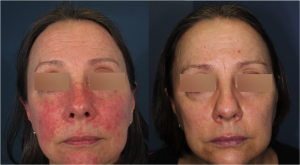4 Key Points on Rosacea
With two million Canadians affected by rosacea, one would think there would be a clearer understanding of this chronic skin condition.
Dr. Rivers is currently President of the Acne and Rosacea Society of Canada. He notes, “A recent survey showed that awareness about rosacea is quite low among Canadians…Since rosacea is visible on the face, there can be significant emotional and social effects for sufferers including embarrassment, anxiety and depression.”
In fact, 75% of rosacea patients report low self-esteem.
Health Canada recognizes Rosacea Awareness Month in April to help bring attention to, and improve the understanding of, the skin condition.
Here are four key points on rosacea that everyone should know:
-
Rosacea may look like adult acne, but it’s not
- Some rosacea looks like acne, with pimples and pustules
- If acne medication or treatments are used on rosacea, they can worsen the skin condition
- Consult with a dermatologist to determine what is causing the redness before attempting to treat it on your own
-
Rosacea can affect the eyes
- Up to half of rosacea sufferers may experience ocular rosacea
- Ocular rosacea can cause red, watery, irritated eyes with red eyelids and/or styes
-
Rosacea can be controlled
- Understanding your rosacea triggers can limit outbreaks
- Consulting a dermatologist for an appropriate treatment will help symptoms
-
Rosacea is more than skin deep
- Sufferers have 5x greater risk for depression
- Rosacea patients often feel anxiety, shame or embarrassment about their appearance
